How Will The 2020 Election Shape Federal Policy on Project Labor Agreements?
The federal contracting community and firms pursuing contracting opportunities for state and local public works projects are keeping a close eye on the outcome of the 2020 elections. It will impact federal policy regarding government-mandated project labor agreements and other hot-button labor and employment issues of importance to the construction industry.
Historically, presidential policies addressing the use of government-mandated PLAs on federal and federally assisted construction projects have been subject to a game of political ping pong since the early 1990s, depending on which party controls the White House.

In general, GOP administrations oppose government-mandated PLAs while Dem. administrations promote their use.
The current federal policy, effective May 2010 by regulations implementing President Obama’s February 2009 Executive Order 13502, encourages federal agencies to mandate PLAs on large-scale federal construction projects exceeding $25 million in total costs on a case-by-case basis. The policy also allows recipients of federal assistance to mandate PLAs on state and local public works projects because the measure rescinded President George W. Bush’s Executive Orders 13202 and 13208, which prohibited government-mandated PLAs on federal and federally assisted projects.
Government-mandated PLAs Harm Taxpayers and Infrastructure Investment
PLAs, when mandated by governments, typically ensure taxpayer-funded construction contracts are awarded only to contractors that agree to recognize unions as the representatives of their employees on that job; use the union hiring hall to obtain workers at the expense of most or all of its existing qualified employees; obtain apprentices exclusively through union apprenticeship programs; follow inefficient union work rules; pay into union benefit and multi-employer pension plans workers will never benefit from unless they meet vesting requirements; and force workers to pay union dues and/or join a union and pay into union benefits plans as a condition of employment.
Discouraging competition from 87.4% of the U.S. construction industry—qualified merit shop contractors and their skilled nonunion construction workforce—via PLA mandates costs taxpayers a fortune. When mandated by a government agency on taxpayer-funded projects, PLAs drive up the cost of construction projects anywhere from 12% to 20%, on average, according to a series of academic studies.
A study released in January 2020 by the Beacon Hill Institute found that Connecticut schools built under controversial government-mandated PLAs cost 19.8% more than schools that were bid and constructed through fair and open competition, free from PLA requirements. Similar research by the BHI and other firms on the impact of PLA mandates on school construction in California, Massachusetts, New Jersey, New York and Ohio found schools built with government-mandated PLAs were 12% to 20% more expensive compared to school projects not built with PLAs.
As state and local governments grapple with record tax revenue shortfalls and budget deficits due to the economic impact of the COVID-19 pandemic, some new construction and infrastructure maintenance projects may be among the first government spending to be cancelled or deferred in an attempt to balance budgets.
With America’s infrastructure in disrepair, now more than ever, taxpayers deserve the best possible construction project at the best possible price, free from anti-competitive and costly PLA schemes that steer contracts to union-signatory contractors and create jobs exclusively for unionized labor.
In the face of elevated construction industry unemployment caused by the COVID-19 pandemic, all qualified firms and all U.S. construction workers deserve a fair opportunity to compete for publicly funded construction contracts to rebuild their communities.
For these reasons, 27 states have responded to the the Obama administration’s support of discriminatory PLA mandates and preferences by enacting Fair and Open Competition Act legislation or executive orders prohibiting government-mandated PLAs on state, local and publicly funded construction projects to some degree. Unfortunately, some of these states have rolled back common-sense FOCA measures following Democratic party takeovers of state government, bringing the total number of current states to enact pro-taxpayer FOCA measures to 25.

Obama Administration’s Pro-PLA Policy Remains
Since the early 1990s, GOP administrations have issued executive orders opposing government-mandated PLAs, while Democrat administrations have enacted policies advocating the use of government-mandated PLAs.
The exception to this trend has been the Trump administration, which has not rescinded and replaced the Obama directive with a taxpayer-friendly policy restricting government-mandated PLAs on federal and federally assisted construction projects similar to George W. Bush’s Executive Orders 13202 and 13208.
However, to date there have been no PLAs on new federal contracts and no expansion of the Obama PLA policy during the Trump administration, despite the lobbying efforts of construction trade unions seeking to expand their market share through government intervention.
While the negative impact of the Obama PLA policy on federal projects has been largely subdued by the advocacy of Associated Builders and Contractors and other coalition stakeholders during the last decade of the Obama and Trump administrations (learn more about ABC’s fight against government-mandated PLAs in this blog post), government-mandated PLAs remain a threat to free enterprise, improved infrastructure and job creation due to their prevalence on federally assisted and other taxpayer-funded public works projects procured by state and local governments in certain markets.
Biden Supports Government-mandated Project Labor Agreements, Construction Union Lobby Priorities
The 2020 Democratic presidential nominee Joe Biden supports government-mandated PLAs and other key policy issues supported by building trades unions.
His clean energy infrastructure plan is full of pro-PLA promises, as is the radical Biden-Sanders Unity Task Force Agenda the Democratic party has touted broadly to shore up the party’s progressive base.
At a Sept. 18, 2020, event at a Carpenters union apprenticeship facility in Duluth, Minnesota, Biden expressed his support for prevailing wage, registered apprenticeship programs and PLAs on federal and federally assisted projects. He also promised to pass the controversial Protecting the Right to Organize (PRO) Act (H.R. 2474/S. 1306).
Passed by the U.S. House of Representatives on Feb. 6, 2020, the PRO Act is stalled in the Senate and is opposed by the Trump administration because it would “kill jobs, violate workers’ privacy, restrict freedom of association and roll back the Administration’s successful deregulatory agenda” and eliminate right-to-work protections across the country, which prevent workers from being forced to join a union and pay union fees as a condition of employment, including the 27 states that have passed right-to-work laws.
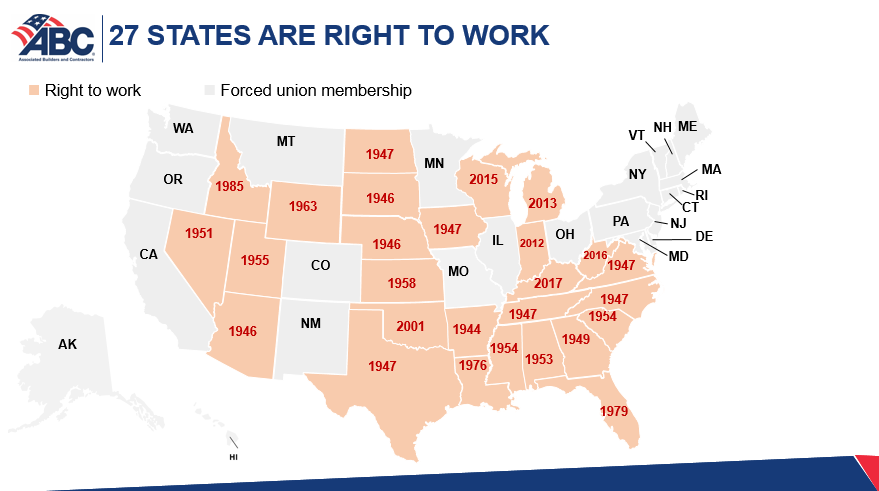
In short, the PRO Act would rewrite 70 years of labor and employment laws and legal precedent to make it easier for unions to increase their membership and send more money to lawmakers, essentially fulfilling Big Labor’s expansive policy wish list and political power and influence indefinitely.
In September, Biden promised to be the most pro-union president in history. He has pledged to create a Cabinet-level working group comprised of labor representatives, “that will solely focus on promoting union organizing and collective bargaining.”
Biden’s support for PLAs, prevailing wage, registered apprenticeship programs and the PRO Act is important to construction trade unions affiliated with the North American Building Trades Union, an umbrella federation of 14 North American unions in the building trades.
To date, all but one of the 14 individual construction trade unions affiliated with the NABTU have endorsed the Biden/Harris 2020 White House ticket, which comes as no surprise to policy experts familiar with construction trade union PAC’s contributions to Democrats and their strong support for the Democratic Party platform.
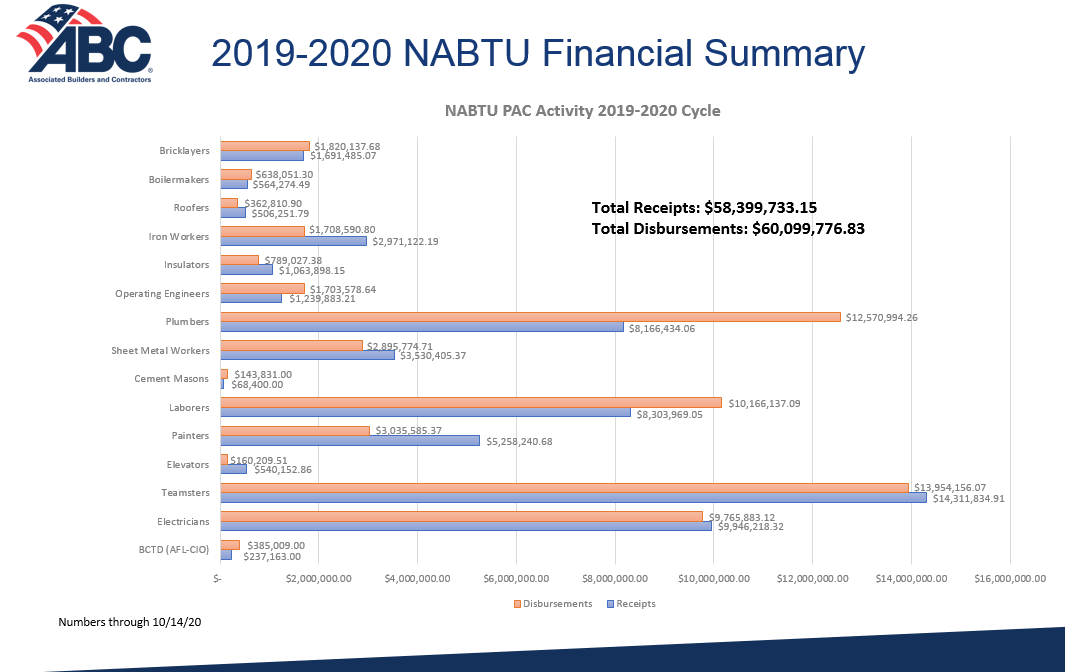
Of note, to date, NABTU itself has not endorsed Biden or Trump. It’s unclear why NABTU hasn’t endorsed a 2020 candidate when the majority of its individual member unions are behind Biden.
Perhaps it is a hedging strategy to have a seat at the table in the event Trump is re-elected to a second term and the GOP maintains one or both chambers of Congress. Since the 2016 campaign cycle, NABTU’s PAC has given more to GOP candidates, a departure from their history of heavy giving to Democrats, while individual construction trade unions still tend to give the vast majority of their PAC dollars to Dem. candidates.
Alternatively, perhaps NABTU’s noncommittal strategy is a way to appeal to a large number of individual union members who are unwavering Trump supporters, despite the fact that union leadership broadly supports the Democratic party’s platforms and the Democratic party’s platform and policies generally benefit the building trades’ lobbying priorities.
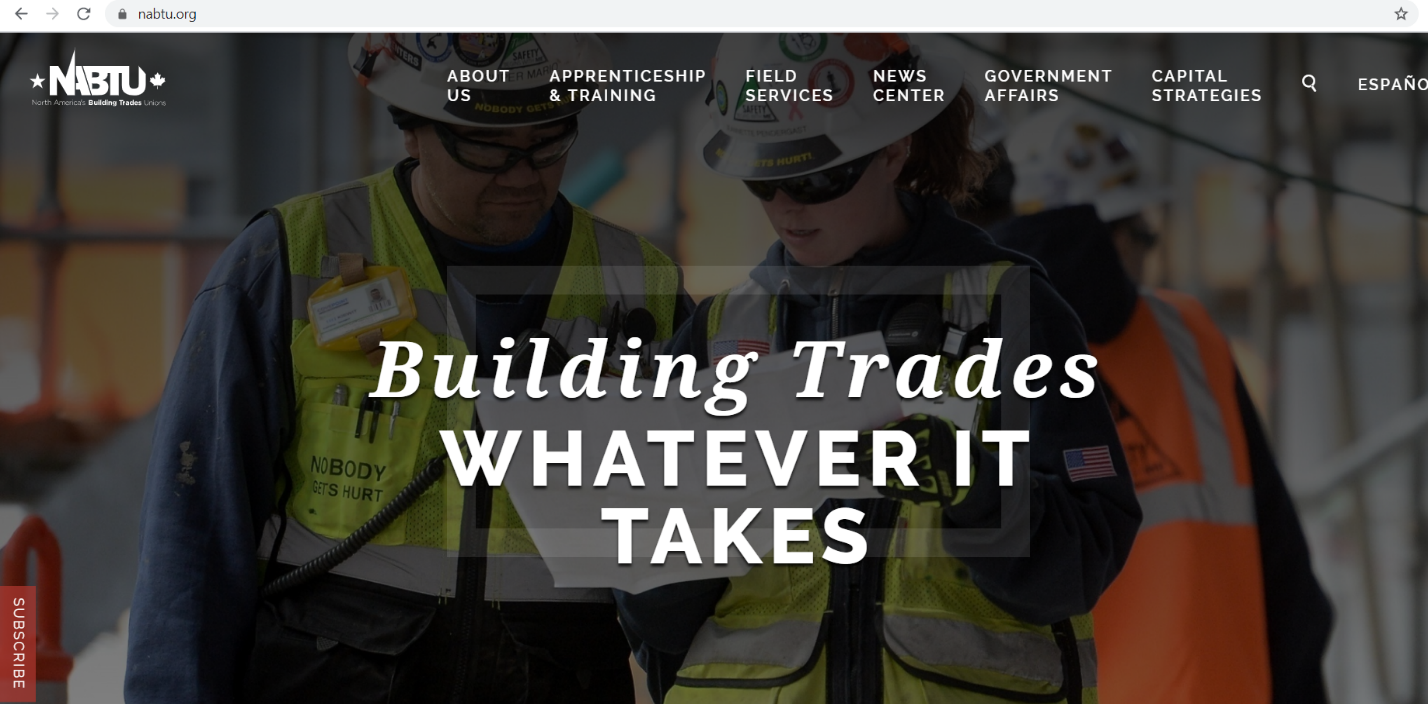
Update: NABTU endorsed the Biden/Harris ticket on 10/23 and the International Union of Elevator Constructors, the last NABTU-affiliated construction trade union that had not endorsed Biden/Harris, endorsed the ticket in this 11/2 op-ed in The Hill.
During the Obama administration, NABTU and its affiliated organizations quietly expressed disappointment with the handful of PLAs on federal projects mandated by the Obama administration, and took issue with the administration’s posture against big energy projects like the Keystone XL Pipeline. Expected to create thousands of union jobs via a private PLA signed by project developers, the Keystone XL pipeline put the Obama in a difficult position between the demands of the environmental lobby and construction union lobby wings of his political base.
While serving as the head of the Obama administration’s Middle Class Task Force, Biden oversaw the implementation of Obama’s controversial PLA policy. His staff, then led by Chief Economic Advisor to the Vice President Jared Bernstein, pushed leadership of the Obama administration’s federal agencies to increase the use of PLAs wherever possible, as explained in this policy piece, “Project Labor Agreements: A better deal for all.”
Of course, if PLA mandates were truly a better deal for all, and not just a sop to special interests that represent less than 13% of today’s construction industry workforce, their use on federal contracts would be more widespread than just a dozen projects out of 1,669 chances during the past 10-plus years.
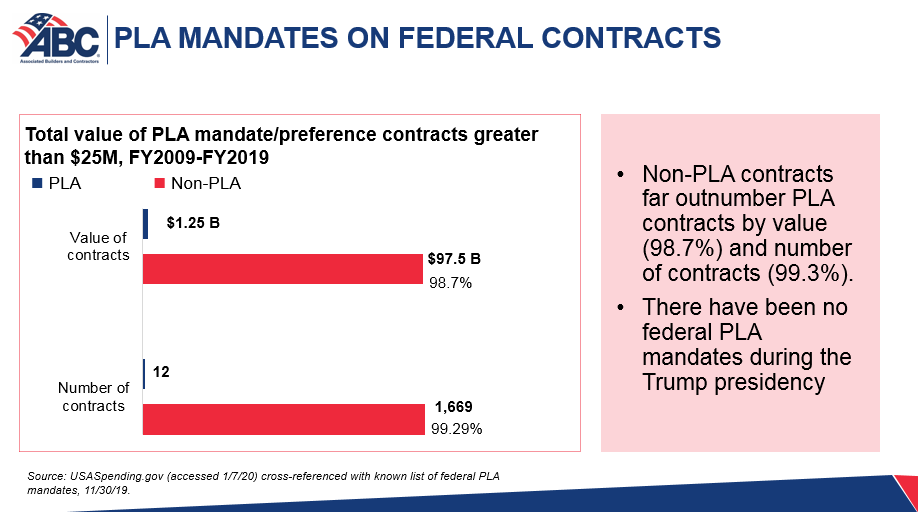
In the last presidential election cycle, Democratic Party presidential nominee Hillary Clinton pledged to expand the use of PLAs on large-scale federal projects and broaden the scope and effectiveness of Obama’s pro-PLA policy.
In early 2016, at the NABTU legislative conference, Clinton promised to gut right-to-work laws, protect the archaic 1930s-era Davis-Bacon Act, create construction jobs exclusively for union apprentices and expand government-mandated PLAs.
In return, construction trade unions’ political war chests and pro-PLA lobby attacked Donald Trump (see IBEW investigation of Trump’s business practices here, Laborers Union President Terry O’Sullivan’s St. Patrick’s Day speech called Trump a “racist, sexist, prejudiced billionaire bully” and Operating Engineers leaders publicly said that Trump is a “snake oil salesman”) and backed Clinton with endorsements, paid media and millions of dollars of political contributions to her campaign and dark money into campaign allies.
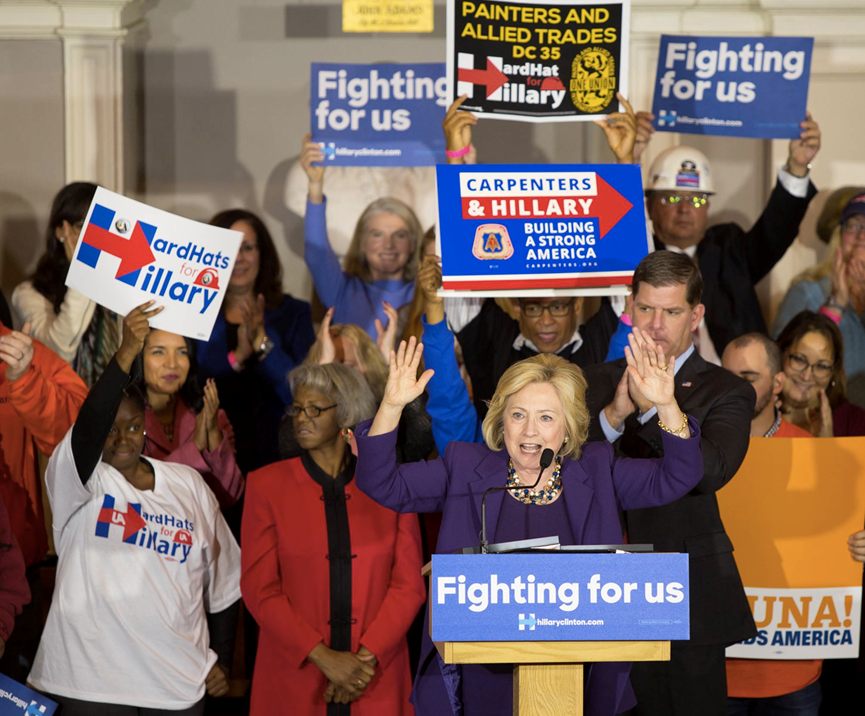
On the campaign trail, Trump made no such policy promises, but he made a concerted effort to woo blue-collar workers in the construction trades and even courted some of their local labor leaders in key presidential battleground states, according to reports.
After winning the election, Trump continued his courtship of rank and file union member voters and brushed NABTU leadership’s attacks and multi-million dollar support for Clinton aside in an attempt to bring construction trade unions into his circle of influence.
President Trump and Construction Trade Unions
On his first full day in office, Jan. 23, Trump invited flattered NABTU officials into the White House for a meeting and press opportunity in support of expanded investment in infrastructure and executive orders rescinding the Obama administration’s positions on the Trans Pacific Partnership trade deal and the Keystone XL Pipeline project—issues of importance to the construction trade unions.
The New York Times reported Trump’s olive branch to NABTU had union leaders scrambling to change government relations strategies and internal messaging. They had to justify their new cozy relationship with Trump to progressive members of their unions and thought leaders of labor’s broad anti-Trump coalition representing public and private sector workers.
On April 4, 2017, Trump keynoted NABTU’s legislative conference in an effort to promote his plans for an infrastructure deal and was greeted with a smattering of boos and protests during his speech (video).

2017 North America’s Building Trades Union Legislative Conference attendees from the IBEW Local 569 and San Diego Building Trades protest President Trump’s speech. (Photo by Olivier Douliery-Pool/Getty Images)
Later, labor leaders critical of Trump pointed out he did not once mention key phrases like PLAs, Davis-Bacon, prevailing wage and registered apprenticeship programs in his speech, nor has he formally defined his position on these key issues of importance to the building trades union lobby.
It has been suggested that Trump was so offended by NABTU’s chilly reception, he made a threat against NABTU’s sacred cow, the Davis-Bacon Act. In a sit down with the New York Times two days after the NABTU kerfuffle, Trump told reporters to expect a big announcement on Davis-Bacon in two weeks, which caught unions and industry by surprise.
It never materialized, but some have speculated it was a strong signal to NABTU officials that they should fall in line with the White House or their policy agenda might face serious consequences.
NABTU President Sean McGarvey and other construction trade union leaders have since largely been on good behavior in public (although McGarvey’s Oct. 6 statement criticizing Trump’s plan to end COVID-19 relief negotiations until after the election was exceptionally harsh and may signal a change in posture). While other labor leaders, such as AFL-CIO head Richard Trumka, have attacked Trump, the construction trades have generally kept criticisms of Trump to themselves. They have dutifully attended White House events on infrastructure and the economy, and served on various Trump taskforces, such as the Great American Economic Revival Industry Groups.
Building trades signatory contractors and individual union member workers, along with construction industry as a whole, have benefited from a booming construction economy during the Trump presidency, as evidenced by a record-high construction spend in 2019 and a 10-year low unemployment rate of 3.2% in May and September of 2019. Additional construction spending via a robust infrastructure plan that has yet to materialize would be an added bonus. However, the biggest complaint from most builders across the country is the lack of skilled labor, which ABC estimated to be 550,000 workers in 2020, before the COVID-19 pandemic disrupted the world’s economy.
NABTU even supported Trump’s June 2017 executive order aimed at “easing the regulatory burden” on apprenticeships in an effort to attract and upskill more labor into all industries. McGarvey and other NABTU member union leaders agreed at the time to join Trump’s related Taskforce on Apprenticeship Expansion which attempted to expand job training to new industries by creating a class of “industry-recognized” apprenticeship programs with less red tape and broader appeal than existing government-registered apprenticeship programs.
However, language in the related June 2019 proposed rule expanding the use of industry recognized apprenticeship programs created a strain on NABTU’s relationship with the Trump administration.
According to reports, NABTU says it had a deal with the administration to exclude the construction industry from the new proposal, to protect the Building Trades’ existing apprenticeship programs from competition from other providers of workforce development opportunities providing career pathways into the construction industry. They took issue with DOL’s language in the proposed rule that said it would not “initially” accept industry-recognized apprenticeship programs for the construction sector but didn’t rule out doing so in the future. That prompted NABTU to aggressively lobby DOL and the White House for a carve out and prevent future reforms to the industry’s outdated apprenticeship policies.
In the end, DOL kept NABTU’s construction industry exemption in the March 2020 final rule, even though the DOL’s current system of federal registered apprenticeship programs cannot meet construction industry workforce development demands.
As highlighted in ABC’s comments on the proposed rule, it would take more than 30 years for federal registered apprenticeship programs to supply the number of new construction workers the construction industry needs today at current graduation rates. (In fiscal year 2018, DOL reported that 17,748 construction industry apprentices completed federal registered apprenticeship programs. If a similar number completed federal registered apprenticeship programs in the construction industry this year, it would supply just 3.2% of the estimated 550,000 additional construction workers that need to be hired in 2020. Thus, at current graduation rates, it would take more than 30 years for the federal registered apprenticeship program to supply the number of new construction workers the construction industry needs to hire just in 2020.).
Following the release of the IRAP final rule, Trump, McGarvey and various NABTU-affiliated construction trade union leaders have continued a relationship. It will again be tested during election season as individual construction unions and members speak out against Trump and support Biden with campaign contributions, independent expenditures, grassroots activities and social media.
Trump The Developer, On PLAs
Trump has not publicly or officially indicated his support or opposition to government-mandated PLAs as POTUS. However, Trump the developer and the Trump business have used PLAs on Trump’s private development projects, on occasion.
The Trump organization has generally declined to voluntarily build with PLAs on Trump development projects in markets with low union membership and market share density (such as the Trump Hotel in Washington, D.C.), but has occasionally executed PLAs with unions on some projects in union-friendly markets in New Jersey, New York City and Chicago with mixed results.

For example, in June of 2006, the company developing the $850-million Trump International Hotel and Tower in downtown Chicago sued three labor organizations for breaching the terms of a PLA after union members walked off the project during a strike (401 North Wabash Venture LLC v. Chicago and Cook County Building and Construction Trades Council, N.D. Ill., No. 06-CV-3077, 6/5/06).
The development company eventually settled the suit against the Chicago and Cook County Building and Construction Trades Council, the Construction and General Laborers’ District Council of Chicago, and Vicinity and Laborers’ International Union Local 6.
Joseph Gagliardo, managing partner of the firm Laner, Muchin, Dombrow, Becker, Levin and Tominberg Ltd., represented 401 North Wabash in the action and told the media that the unfortunate lesson emerging from this strike and suit has to do with the real value of PLAs with Chicago unions.
“The whole purpose of the project labor agreement is to prevent interruption and prevent delay and have labor peace,” Gagliardo said in response to media reports about the case. “So the question this strike raises is—and I don’t know the answer to it—what impact will this strike have on the willingness of other building owners to engage in a project labor agreement?”
Trump’s personal experience of broken promises on a PLA project in the private sector is not unique. TheTruthAboutPLAs.com has documented numerous problems on contracts subjected to government-mandated PLAs, including failures on federal and federally assisted contracts that resulted in increased costs, delays, poor local hiring outcomes and safety violations.
Future Federal PLA Policy Dependent on Election Outcome
It’s clear the 2020 elections will have a big impact on public works contractors, their workforce and investment in America’s infrastructure.
Trump is more likely to rescind and replace the current pro-PLA policy or keep the status quo. Supportive of the Trump administration’s actions and policies on key issues such as tax reform, regulatory reform, workforce development, criminal justice reform and a general pro-small business agenda, ABC endorsed Trump in August.
In contrast, Biden is sure to prioritize anti-competitive aspects of the building trades policy agenda. A Biden administration will expand or give more teeth to the current federal pro-PLA policy, which is unfortunate because taxpayers and the merit shop contracting community deserve relief from anti-competitive and costly policies promoting government-mandated PLAs. Fair and open competition is the only way to give taxpayers the best possible product at the best possible price.
No matter who is in the White House or Congress, ABC will continue to implement effective legislative, legal and regulatory strategies complemented by communications and grassroots campaigns to educate federal agency procurement officials, lawmakers, industry stakeholders, the media and taxpayers about the harmful effects of special interest PLA schemes.
ABC will always fight for federal, state, and local policies that create a level playing field in the procurement of government construction contracts, increase competition, help small businesses grow, curb construction costs and spread the job-creating benefits of taxpayer- funded contracts throughout the entire construction industry.
But we cannot do it alone. The merit shop contracting community can overcome these discriminatory PLA schemes as long as industry leaders remain diligent, support candidates who believe in free enterprise, and continue to educate lawmakers, voters, employees and stakeholders about this campaign until a political or legislative solution is achievable.











